Choosing the most suitable development environment is a significant step that determines the future of the product. Wrong decisions can lead to development failure. Today we will talk about two giants in app creation for Apple devices and decide which is better to use in 2021: Swift or Objective-c. Read this guide and get answers to all your questions.
What is Objective-C?
Objective-C was created in the 1980s by Brad Cox and Tom Love based on the C programming language and Smalltalk paradigms. The Objective-C language is a superset of the C language, so the C code is completely understandable by the Objective-C compiler. The goal of Cox and Love was to address the issue of code reuse to reduce system resource requirements and improve code quality and performance. The threshold for entering object-oriented programming is quite high, and for beginners, it becomes a real challenge. Therefore, another goal was to make the new programming language very simple so that developers can quickly make the transition.
In 1988, Objective-C was licensed by NeXT. AppKit and Foundation Kit were also added to the language, and its libraries were improved. Later, this served as the basis for creating the NEXTSTEP development environment.
In 1996, Apple bought NeXT Software, and the NEXTSTEP development environment became the primary development technology for the future major version of the Apple operating system - OS X. After purchasing NeXT, Apple took their SDK (compiler, libraries, IDE) as the basis for their further development. The IDE for code development is called Xcode, and the GUI (Graphical User Interface) is called Interface Builder. Until 2014, all native iOS applications were created using Objective-C.
Before the release of Swift, Objective-C was ranked 7th in the list of most popular programming languages. Some native applications are still being built using Objective-C, although Swift has become more popular for this. Objective-C has evolved from being the leader in developing iOS applications into a tool for maintaining existing products.
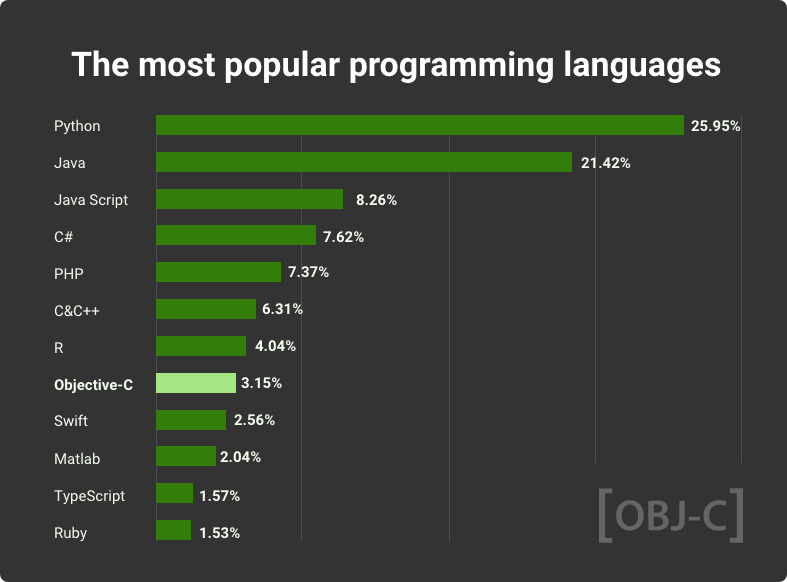
The Most Popular Programming Languages In The World
Objective-C Pros
Here are some of the main advantages of Objective-C.
Dynamic and Adaptable
Objective-C’s main characteristic is its high dynamism, allowing iOS developers to change method invocations at runtime. This is made possible by the Smalltalk paradigm. Objective-C is characterized by high adaptability during the execution of tasks. In turn, this feature gives developers access to private APIs or to simulate objects during program execution. It is an advantage for unit testing, which ensures the stability and reliability of the application.
Stable and Mature
As you already saw, this programming language was created over 30 years ago. During this time, it has become a very stable and reliable tool for application development. Objective-C does not require constant updates and new releases. You can safely develop an application using Objective-C, and be sure that you will not be bothered with additional funds for porting your product to another, more stable platform.
Compatibility With C and C++ Libraries
C++ is widely used for software development. Although it appeared in 1983, this object-oriented language is still considered a reliable tool for developing complex software. Based on C, C++ has become a progenitor for C#, Cyclone, Java, BitC, and Nim. Since Objective-C is a superset of C, it can easily recognize C and C++ code. Objective-C is an excellent choice if you are developing your application using third-party C and C++ libraries.
Well-Tested Language
During the use of this programming language, millions of lines of code have been written. All compiler errors have been found and fixed long ago. When developing code using Objective-C, you can be sure that you will not encounter unexpected or incomprehensible errors.
Build a top-notch iOS application by partnering with a trusted development team from KeyUA.
Contact UsObjective-C Cons
Nevertheless, this programming language has significant disadvantages.
Difficult Syntax
Objective-C has a steep learning curve. It differs in syntax from other programming languages, so it is pretty hard for beginners.
Debugging is Tricky
Debugging an application can also be a real challenge due to the dynamic nature of Objective-C. And the language itself does not help developers very much in solving these problems.
Uncertain Future
Recently, this tool has been used less and less for application building. Developers now apply its paradigms mainly to support some of the products developed before Swift was released. Some rumors from Apple say that interest in Objective-C will be lost sooner or later, and the company will stop supporting it.
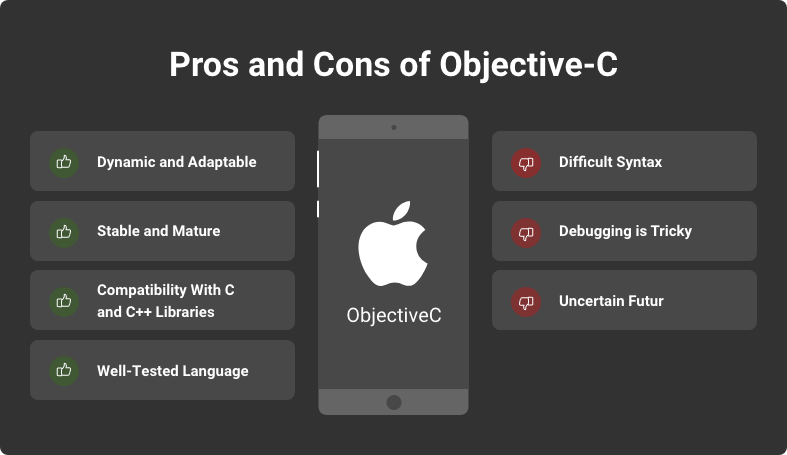
The main advantages and disadvantages of Objective-C for developers
Popular Products Built with Objective-C
Objective-C was used for the development of all applications that were released for Apple devices before 2016. It was the de facto standard for building software for iOS or macOS. Objective-C served as the basis for everything previously popular in the App Store and Apple's default software. Many of these applications still use some blocks written in Objective-C, although their main functionality was redone with the help of Swift. Thus, all popular applications that were published in the App Store before 2015 were written in Objective-C.
What is Swift?
In 2005, Chris Lattner joined Apple. His task was to develop LLVM. It is a software infrastructure project for building compilers and related utilities. Apple used it to improve the way they use Objective C to build applications.
It turned out that Chris Lattner was in charge of absolutely all the tools and directions with which Apple applications were created (software for phones, tablets, laptops, desktops, and all other devices), including native and third-party products.
In 2010, Lattner began work on Swift. For more than a year and a half, he kept his project secret, developing it in his free time. Then Lattner decided to share his invention with Apple's senior management, who highly appreciated the idea. After that, Lattner got a couple of developers to help him officially continue work on the project.
Nevertheless, the project was still a secret development. But while the secret development continued, Latner's project was included in the list of Apple's priority areas. When it came out, people who indirectly worked on it were significantly surprised by what this idea actually turned out to be.
The first release of Swift took place in 2014. It was positioned as a faster and more efficient programming language for creating iOS and macOS applications. It has become the fastest-growing programming language in history. Unlike Objective-C, Swift was built for the average developer. It is easy to learn and has a syntax that allows programmers to self-learn.
In 2015, Apple made Swift open source to all interested. Now any software developer, college student, or beginner can develop and optimize this language.
In 2020, Swift entered the top ten most in-demand programming languages.
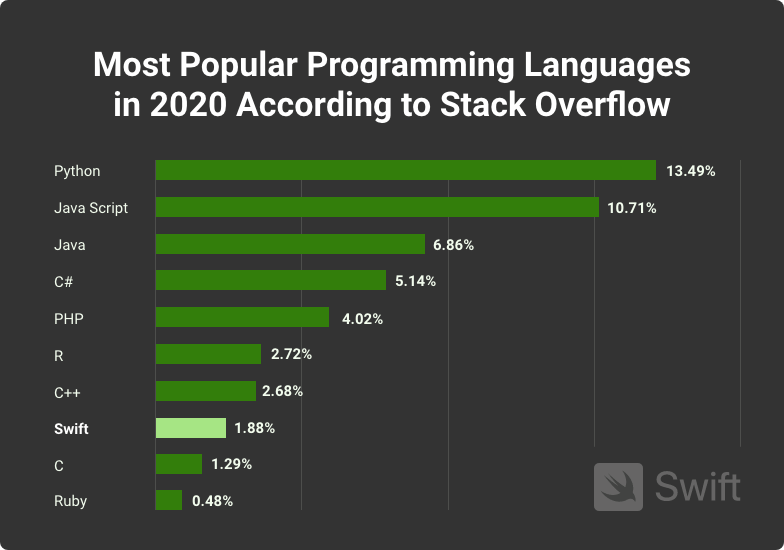
Most Popular Programming Languages in 2020 According to Stack Overflow
Swift Pros
Look at some advantages of Swift over Objective-C:
Simplicity
The main feature of Swift is its simplicity; even a novice programmer can master this language. Syntax simplicity is a significant challenge for Swift's developers, and they've done an excellent job of it.
Safety
Swift has a well thought out and reliable structure, due to which applications developed in this programming language have less vulnerability. This is a significant factor if you need to create a safe and dependable product.
Advanced Functionality
Another distinctive feature is advanced functionality, memory management, and support for dynamic libraries. Swift can also fully interact with the Objective-C code.
High Speed of Development
Swift is about rapid app development. According to some sources, the speed of its algorithms’ implementation is 3.9 times faster than that of Python, the most popular and high-performance programming language. This means that the developer will need less time to create a product.
Cross-Platform Development
Cross-platform development allows you to create a single container, which can later be relatively easily adapted to iOS and Android features. It becomes a more popular way of creating mobile applications every year, as it is faster and less expensive than native development. Since 2016, Swift is available for developing applications running on the Google platform. Thus, the new programming language released by Apple has become a cross-platform toolkit, thanks to which you can create highly productive applications that are not inferior to native ones.
Open Source
Since Apple has made its programming language available for wide use, it does not require a license, which means the development environment can be deployed on any machine. This also reduces the cost of app building.
Looking for experienced Swift developers? For over 5 years, our programmers at KeyUA have been delivering top-notch mobile products using this tool.
Contact UsSwift Cons
Despite all its strengths, Swift still has some disadvantages:
Constant Changes
Swift is continuously updated and requires improvement. Thus, a significant drawback arises - the need to switch to the latest versions, which entails additional costs of money and time.
No Support For Earlier Versions
Swift does not support some older versions of iOS and macOS since the language is still relatively young. Thus, there is no way to update or maintain applications for earlier operating systems that consumers still use.
Absence of C++ Import
Unlike Objective-C, Swift does not support C and C ++ code. This is a significant drawback if you need to create an application using these libraries.
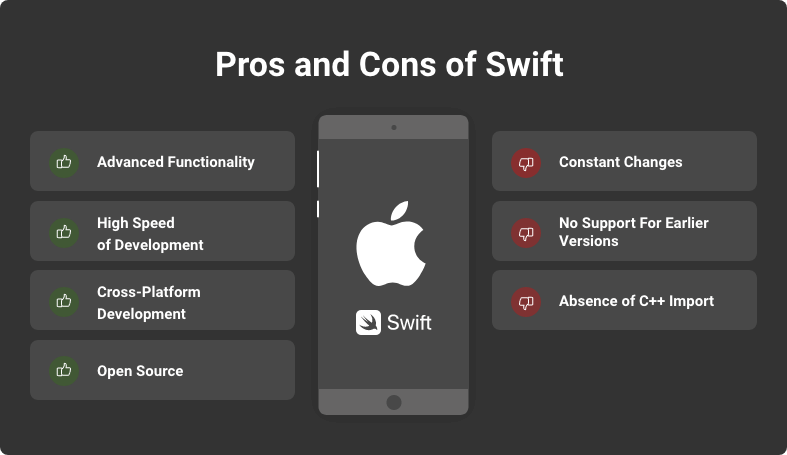
The main advantages and disadvantages of Swift for iOS Developers
Popular Products Built with Swift
Many of the world-famous applications that we use almost daily are created with the help of Swift. Let's take a look at some of them.
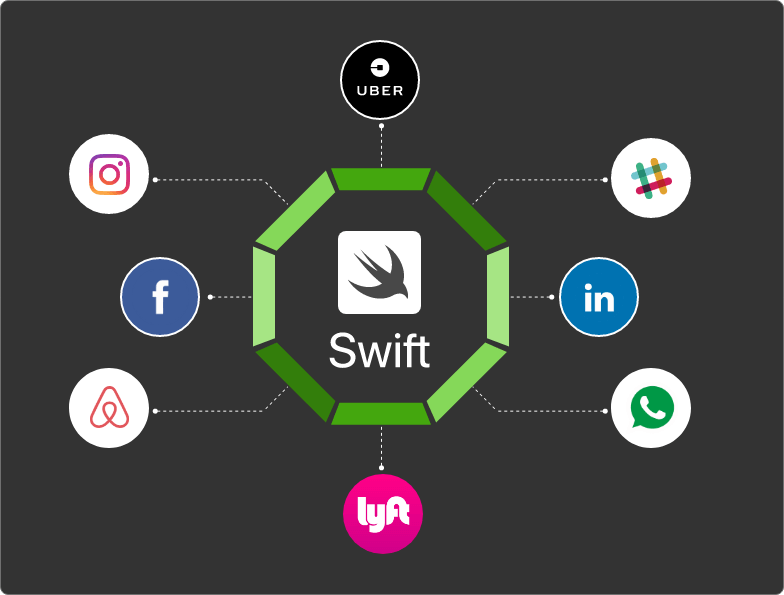
Here are some popular apps built using Swift
Facebook. The mobile application for Facebook was developed with the help of Swift. This is significant evidence of how effective it is as an android and ios coding language.
Uber. One of the most popular taxi booking apps is also built with Swift. Developed in 2009, Uber is now available in over 700 cities around the world.
Slack. It is a business communication platform that is great for teams of all sizes. Slack's mobile app is entirely based on Swift, which is why the app is so fast, even when many people are involved in the chat.
Lyft. This is another popular travel booking app that is available in the United States. Lyft's motto is "your friend with a car." It is a friendly service with which you can order a car at your convenience.
LinkedIn. It is an indispensable tool for building your professional brand. Linkedin is a social network that connects you with employers, recruiters, and colleagues around the world. They used Swift as a robust tool to build a scalable platform.
WhatsApp. Another application that is used all over the world is WhatsApp. It is a convenient messenger that ensures the confidentiality of correspondence due to Swift. WhatsApp is a free app and uses internet access to make calls and chats.
Instagram. Instagram has revolutionized the world of photography. With it, even ordinary users have learned how to take professional photos. This social network has millions of users around the world who upload personalized content for everyone to see. Since Instagram needs extraordinary processing power to process tons of photos, videos, and text, it uses Swift to ensure high productivity.
Airbnb. It is a giant in the tourism industry. The application allows you to book apartments or rooms in over 190 countries worldwide, serving customers making short-term rentals. In addition, the mobile application has extra functions as compared to the web-version. For example, it offers discounts that you will not find searching through a laptop.
Main Difference Between Swift and Objective-C in iOS
Below we have presented the main differences between the two languages for creating iOS and macOS applications.
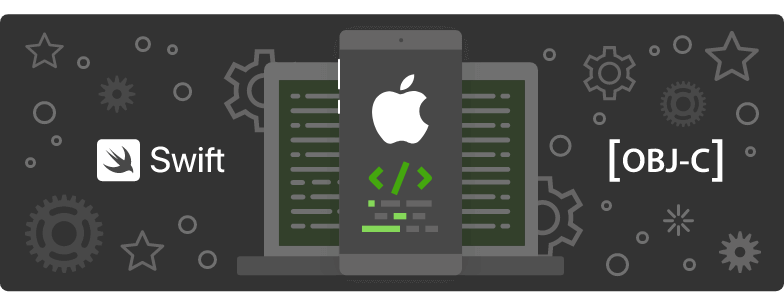
Performance
Apple claims that Swift is almost 3 times more productive than Objective-C. But practical studies show that the difference in performance is pretty small (Swift's advantage) because both iOS app programming languages use the same SDK (Software development kit).
Safety
One of the significant Swift vs. Objective-c differences is safety. Swift is a more stable and memory-safe programming language, while Objective-C, having absorbed the features of C and C ++, gains full access to it. In case of errors in the code, access to memory can lead to important data accidentally being deleted.
Maintenance
Maintenance of applications created with Swift is more straightforward and less expensive. The complexity of servicing Objective-C products is that it uses two types of files (.h and .m). The .h file is a header file for public declarations of the class like an API, while the .m file is the private implementation. Both files must be changed to update the application.
Code Complexity
There is also one more advantage of Swift over Objective-C. The first tool’s code is much simpler and requires fewer lines to build the application. The lighter and more compact the code, the easier it is to update and maintain an application. As a result, fewer resources are spent on it.
Learning Curves
Swift is a more natural language to understand and learn. It is designed so that a newbie in programming can easily get started. Things are quite different with Objective-C. It has a very steep learning curve, and not everyone can master this language.
Community
Swift is an open-source language, so it is accessible to a wider circle of people. The more developers that learn a language, the faster it will modernize and improve. The Swift community is growing at a rapid pace. Objective-C also has a vast community, but due to the fact that Swift occupies a large market share, it is gradually decreasing.
Functional Programming Features
Swift is a function-based programming language. It has higher-order functions, functions as values, nested functions, closures, anonymous functions, and other functional programming attributes. Objective-C is an object-oriented programming language that focuses on using objects and blocks instead of functions. Thus, the code written in Objective-C is almost 4 times longer than the code created with Swift.
Let's summarize the information above and combine the features of the two programming languages into a pivot table.
Objective-C vs. Swift Comparison
Factors | Objective-C | Swift |
Supporting Platforms | iOs, macOS | Cross-platform |
Experience | Mature | Young |
Syntaxis | Complicated | Concise |
Code Lengths | Lengthy and complex code | Lighter code |
Security | Lower level | High level |
Readability | Complicated readability | Easier to understand |
Libraries Support | No support for dynamic libraries | Dynamic libraries supported |
Performance | A little bit slower | Faster |
When to Use Swift and Objective-C for Project Building
As you may have noticed, Swift has a lot of advantages over Objective-C. But do you need to use it for all products? Let's take a closer look at use cases for both programming languages.
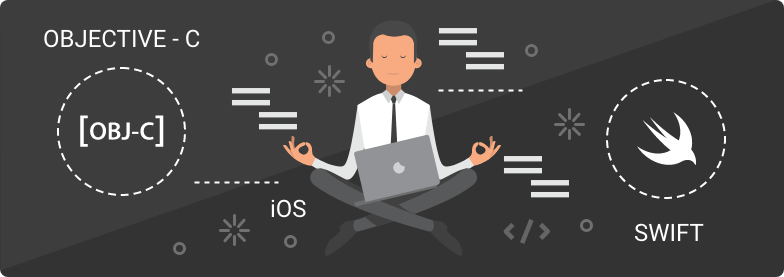
Why Give Preference to Objective-C
If the application has a considerable code base
If your application was initially written in Objective-C and has more than 100,000 lines of code, there is no point in porting it to Swift. It is best to update and maintain your product using the C constructions. Also, note that Swift and Objective-C do not conflict with each other. In the case of a scalable product, you can have different parts of the application written in two programming languages. In general, Objective-C is mainly used to support scalable applications that were originally written in this code.
Why use Swift
1. Minimum Coding Effort
Swift is simpler to compile and is less likely to have errors in the code. This is achieved through built-in support that manipulates data. When re-writing the functions, the swift requires less effort on the part of the developer.
2. Less Maintenance
Many startups prefer Swift because of the low cost of maintaining apps. As we said earlier, when developing an Objective-C code, two files are used. In order to update the application, the developer will have to manage both of them. This increases the time required for building. When writing Swift code, one program file is used. That's why maintaining products written with this programming language is easier.
3. App Will Occupy Low Memory Space
Swift uses dynamic libraries. This improves the application’s productivity as they are loaded directly into the application memory, reducing their original size. If you need a project that requires processing large amounts of information quickly, Swift is a good solution.
4. Cloud Solutions
Another swift vs. objective-c difference is that the first one is an excellent tool for building cloud-based applications. This also makes Swift the preferred language for developing enterprise apps.
Conclusion
Mobile technologies are advancing rapidly. Programming languages, which were in demand a few years ago, go into the annals of history, and advanced and faster tools take their place. Swift was released as a development language for iOS applications just 6 years ago but has quickly pushed ahead of Objective-C, which at one time was the development standard for all applications running on Apple devices.
Now Swift is a reliable and productive development environment that is also used for building cross-platform applications. Considering all its advantages and disadvantages, Swift is the one that should be chosen for mobile development in 2021.
Have a cool idea for a mobile app? Let's do it together! At KeyUA, we have been delivering quality products for iOS and Android for over 12 years.
Contact Us







 Unit 1505 124 City Road, London, United Kingdom, EC1V 2NX
Unit 1505 124 City Road, London, United Kingdom, EC1V 2NX

Comments
Leave a comment